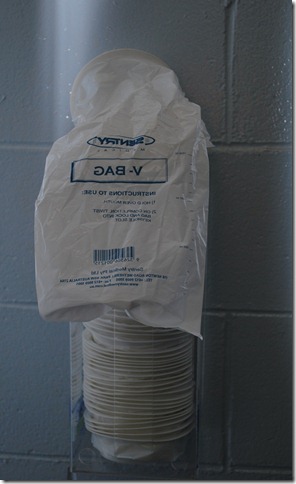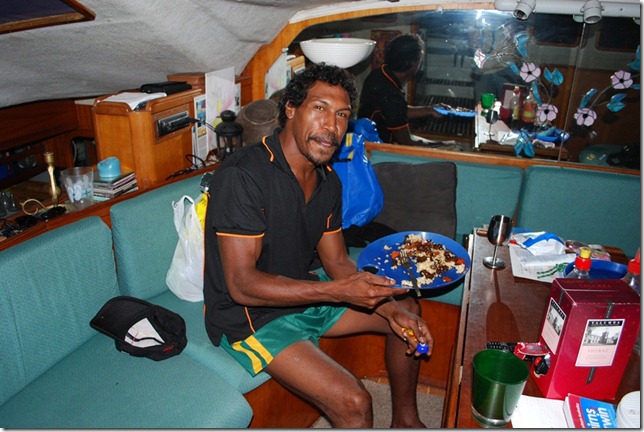We’ve made it over “The Tip”, as the locals call Cape York, the northernmost point of the Australian mainland. We covered the 320+ nm distance from Lizard Island to Cape York in about 48 hours, giving us an average speed of better than 6.6 knots, which is probably a record for us. All we had to do is unfurl the jib a couple minutes after leaving Lizard Island and then gibe occasionally when our course changes through the GBR caused the following winds to come from the opposite quarter. We had plenty of wind the whole time, with the strongest winds coming the second night – sustained 40 knots for a bit with gusts over 50 knots. The boat really did well, though, and the reefs and islands kept the seas from getting as big as they would have if we’d been offshore, so overall we were pretty comfortable.
Passing through the Torres Strait is often a bit of a nightmare for people because of the strong tidal currents and shipping traffic, but we were fortunate to have a great passage. We were planning to anchor at Albany Island, just before the straits to get some sleep and wait for good tide conditions and daylight, but our timing was perfect, so we just kept sailing. We arrived just after sunrise, with the wind at our back and the tides in our favor as well. We were arriving just after a low tide, so the current would be running with both us and the wind (against us would have slowed us and against the wind would have resulted in steep seas). It was also a half moon, so the tides (and currents) weren’t as extreme, and this was the second high tide of the day, which was much smaller (again, less current) than the day’s earlier high tide. Pretty good luck overall. As we sped toward the Cape doing 7 knots on just the jib, we enjoyed sunny skies and light seas that left the boat feeling like it was at anchor.
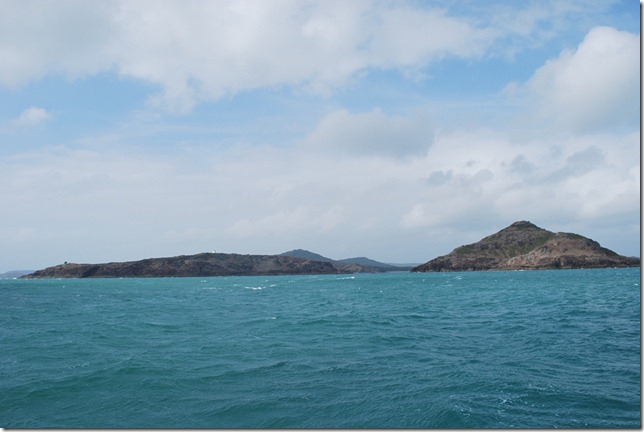 Cape York about a mile away between Ecobar (l) and York (r) Islands
Cape York about a mile away between Ecobar (l) and York (r) Islands
By early afternoon, we’d entered the Endeavor Strait and dropped anchor at Seisia (SAY-see-uh) where we were planning to pick up a few fresh groceries. Seisia is our first real outback experience, and our first day here has been an interesting one. The mainland is covered in brush and red dirt. As soon as we went ashore we started seeing 4x4s with snorkels for crossing outback rivers and it seemed like half the men were wearing the stereotypical Aussie outback hats (think Crocodile Dundee). Over half of the community of Seisia consists of an RV campground with 16 sites. A wharf where a supply ship and ferry stop, a grocery store, a gas station, mechanic/junkyard, and a few houses and trailers make up the rest of the greater metropolitan area. There are two common signs around town. One is posted at the supermarket and gas station and states that by order of the local council, no children will be served between 9am and 3pm Monday through Friday (apparently school is really no fun here). The second one is an ad for a local politician that says “No wild rivers without our consent”. We’re still trying to figure out that that one means.
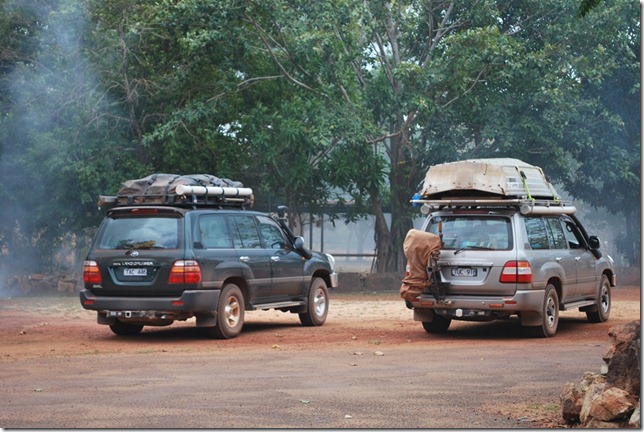 The “tinnie” (aluminum boat) on the 4×4 is pretty common
The “tinnie” (aluminum boat) on the 4×4 is pretty common
We decided to try hitching a ride to Bamaga (BAM-uh-guh seems to be close), a few miles away, and after watching some free range horses cross the road in front of us, we were picked up by a couple of women in a youth club truck who informed us that the giant piles of dirt we’d seen on an island on the way in and that we were passing in the truck were anthills. We saw one on the way that was about 7 feet high and 3 feet or so wide at the base. The ants aren’t anything special in terms of their size, but the anthills are something to see.
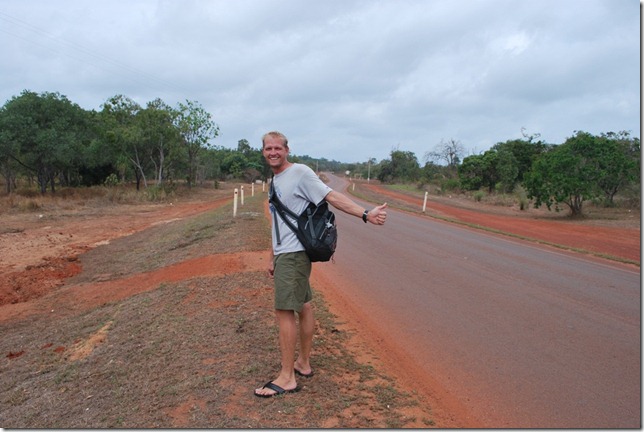 Hitching is easy work here – the place is small and people are friendly
Hitching is easy work here – the place is small and people are friendly
Bamaga is something of the local big city, with a larger grocery store, a bar, a bakery, and a general store, a resort, and a post office. The largest and nicest buildings in Bamaga seem to be the local government and unemployment offices. We asked about some internet access where we could use our computer and it turns out that there are only two internet cafes/hotspots in the 5 communities here. It was definitely starting to feel more like the islands than a first-world country. After checking prices at the grocery store (try $7.50 for a tube of Pringles) we wandered over to the bar. Of course they were playing MTV, just to make sure that even the most remote places of the world can recognize Brittney Spears and her latest #1 video. The rules posted in the bar were numerous and seemed to indicate that drinking was a bit of a problem, presumably primarily with the local aborigine population. There was a list of bad behavior, complete with the associated ban times for each offence (e.g., refusing to leave when asked is a 3 month ban), a notice that the associated drive-though liquor store would no longer be serving patrons on foot, rules against falling asleep and begging for money, cigarettes, or beer, and a list of the limit for in-bar and takeaway alcohol purchases. I took a moment to use the restroom and found something I’d never seen before – a stack of bags to vomit in. Apparently this is a big enough problem that the bar has purchased the bags and put a dispenser in the bathroom. The funniest part is that there are detailed instructions on the bags about how to vomit in them and then throw them away, but all the instructions are printed backwards, as though you’re supposed to read them with your rearview mirror. Of course there’s no mirror in the bathroom and the bags are presumably for the severely intoxicated. Hopefully they can either backwards even when drunk or somehow manage it without detailed instructions. Needless to say, we’re disappointed to be here on a Monday afternoon instead of a weekend night when we could apparently expect to be in for some pretty entertaining people-watching.
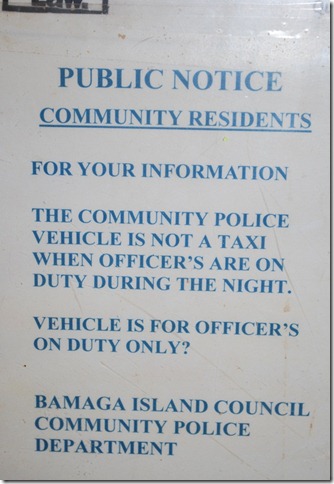 One of my all-time favorite signs
One of my all-time favorite signs
We eventually met a local islander/aborigine named Noel (NOLE) who had a lot of interesting stories about life here in the far north. He joined us for dinner on the boat, which was delayed just a bit by having to remove and clean the carburetor again. Apparently the islands between here and Papau New Guinea were populated by people now called islanders who were different in terms of language and cultural from the aborigines of the mainland, although some intermixing did occur. For instance, Noel’s Dad is an islander from Thursday island, while his mother is from the mainland. When we asked him how many brothers and sisters he had, he said “heaps” – some in each of the local communities. Many of his stories were about how the natives put meat on the table. They hunt dugongs (manatees) by simply taking a dinghy out and drifting along until the curious dugong comes nearby and then they spear it and take it back with a larger dinghy. Lobsters are plentiful at Cape York itself, where they brave the rough seas and strong currents to freedive and catch them. Sea turtles are plentiful and are taken occasionally as well, but only a couple of fish can be speared at a time before sharks become a risk. Last night Noel was planning to go crabbing with friends at midnight, when the moon rises and the crabs apparently come out to forage on the riverbank. Wild cows and bulls can be shot near Weipa (a five hour boat ride). Apparently most of the livestock ranges free, but the cows and bulls with no brands are wild and for the taking. In some places they’re right up on the beach and they’re able to shoot them from the boat, but if they go to hide in the dense, impenetrable scrub, they use another trick. They start a grass fire and burn a large area near the edge of the scrub. A couple of days later, green shoots of grass appear in the burned areas and the cows and bulls, who have a serious craving for fresh green grass, wander out just before sunrise to enjoy the delicacy. That’s when they become the delicacy for friends and family. Kangaroos are hunted as well, but Noel says that even though croc tail tastes like chicken they generally don’t hunt it because it’s too dangerous. He’s seen a man get killed by a croc. Apparently the guy was a long time croc hunter who risked swimming from a river shore to a waiting ferry at night and only made it part way. Noel and others found his body underwater where the croc had brought it back to stash it and eat it later. Crocs are apparently protected now, but it sounds like there are plenty of people who still try to kill them when possible to avoid becoming prey at some point in the future. After all the croc stories and the strong currents here I was glad that the repaired outboard ran well when I dropped Noel off at shore to go crabbing. In the dark, the wharf lights showed at least 20 people fishing and pulling squid to make calamari.
Noel also said that many people believe there are “wild people” (aborigines living in the traditional way) out in the bush. One look at a map of the area makes it clear there’s plenty of unoccupied space and there have certainly been plenty of reasons for mistrust between the natives and whites in the past. He says sometimes when they’re out in the bush acting as rangers or hunting, they find unexplained fires that are still warm, see smoke, or see people in the distance. That one may be a tall tale, but this place is definitely a far cry from Cairns, with its blocks of tourist shops and restaurants and fleet of boats that carry hundreds of tourists daily.


